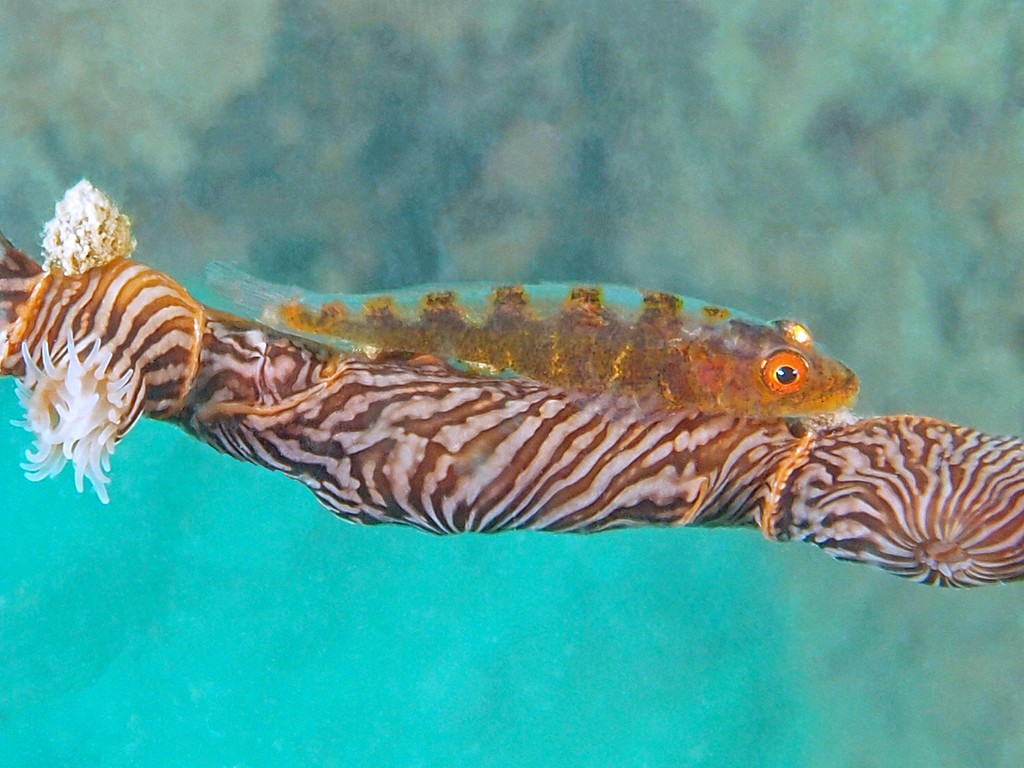BRYANINOPS AMPLUS - (LARSON, 1985)
Actinopterygii (Gigaclass) > Actinopteri (Class) > Teleostei (Subclass) > Gobiiformes (Order) > Gobioidei (Suborder) > Gobiidae (Family) > Gobiinae (Subfamily) > Bryaninops (Genus)
Gobie nain des gorgones, Gorgonian goby, Large whip goby, Large Whipgoby, White-line seawhip goby, Gorgonian dwarfgoby,
Description
Épines dorsales (Total): 7; Rayons mous dorsaux (Total): 6-9; Épines anales 1; Rayons mous anaux: 6 - 9. La taille adulte de Bryaninops amplus atteint 5 cm, et sa morphologie longiligne et fine lui confère la meilleure protection possible pour passer inaperçu. De plus, le corps est transparent, comportant des motifs dans les tons rouges ou verdatre et une raie noir longitudinale d'un blanc argenté, au-dessus du niveau de la colonne vertébrale. Bryaninops amplus évolue entre cinq et plus d'une trentaine de mètres de profondeur.
Biotope
Bryaninops amplus se trouve généralement à la surface de coraux fouets, Junceella fragilis (Ridley, 1884) et Junceella juncea (Pallas, 1766), plus rarement de gorgones et des alcyonaires comme Ellisella maculata (Studer, 1878) ou même, parfois, de lignes d'ancrage de bouées près des zones côtières habitées.
Distribution
Indopacifique occidental, y compris dans l'archipel des Maldives. Présent en Nouvelle-Calédonie.
Biologie
La détermination précise de l'espèce n'est pas toujours chose facile. Les critères essentiels sont les couleurs de la livrée ainsi que l'hôte utilisé comme support.
Synonyme
Bryaninops ampulus (Larson, 1985)
-----------------------------
Description
Dorsal spines (total): 7; Dorsal soft rays (total): 6-9; Anal spines: 1; Anal soft rays: 6 - 9. Characterized by semi-transparent reddish body color, blends in well with host gorgonian; iris with gold inner ring, broad red outer ring; 2-4 lowermost pectoral rays are unbranched; longitudinal scale series 37-79; short and cup-like pelvic fins; thickened and lobed skin surrounding pelvic spines; opening of gill extending ventrally to below pectoral fin base. Max length: 4.6 cm. Depth range: 1 - 30 m, usually: 5 - 20 m.
Gobie nain des gorgones, Gorgonian goby, Large whip goby, Large Whipgoby, White-line seawhip goby, Gorgonian dwarfgoby,
Description
Épines dorsales (Total): 7; Rayons mous dorsaux (Total): 6-9; Épines anales 1; Rayons mous anaux: 6 - 9. La taille adulte de Bryaninops amplus atteint 5 cm, et sa morphologie longiligne et fine lui confère la meilleure protection possible pour passer inaperçu. De plus, le corps est transparent, comportant des motifs dans les tons rouges ou verdatre et une raie noir longitudinale d'un blanc argenté, au-dessus du niveau de la colonne vertébrale. Bryaninops amplus évolue entre cinq et plus d'une trentaine de mètres de profondeur.
Biotope
Bryaninops amplus se trouve généralement à la surface de coraux fouets, Junceella fragilis (Ridley, 1884) et Junceella juncea (Pallas, 1766), plus rarement de gorgones et des alcyonaires comme Ellisella maculata (Studer, 1878) ou même, parfois, de lignes d'ancrage de bouées près des zones côtières habitées.
Distribution
Indopacifique occidental, y compris dans l'archipel des Maldives. Présent en Nouvelle-Calédonie.
Biologie
La détermination précise de l'espèce n'est pas toujours chose facile. Les critères essentiels sont les couleurs de la livrée ainsi que l'hôte utilisé comme support.
Synonyme
Bryaninops ampulus (Larson, 1985)
-----------------------------
Description
Dorsal spines (total): 7; Dorsal soft rays (total): 6-9; Anal spines: 1; Anal soft rays: 6 - 9. Characterized by semi-transparent reddish body color, blends in well with host gorgonian; iris with gold inner ring, broad red outer ring; 2-4 lowermost pectoral rays are unbranched; longitudinal scale series 37-79; short and cup-like pelvic fins; thickened and lobed skin surrounding pelvic spines; opening of gill extending ventrally to below pectoral fin base. Max length: 4.6 cm. Depth range: 1 - 30 m, usually: 5 - 20 m.
Etymology
Bryaninops: from the former similar or related genus Bryanina now, Sicyopterus + from Ancient Greek, óps = eye, face, appearance.
Distribution
Indo-Pacific: Natal, South Africa and Madagascar to the Hawaiian Islands, north to southern Japan, south to the southern Great Barrier Reef. Reported from New Caledonia.
Biology
Benthic spawner. Live exclusively on, or in close association with gorgonian seawhips Junceella fragilis (Ridley, 1884) and Junceella juncea (Pallas, 1766) which usually occur in groups in areas exposed to currents at depths of 5 to more than 30 m. May also live on other species like Ellisella maculata (Studer, 1878) or even on mooring lines. Harvested for aquarium trade.
Distribution
Indo-Pacific: Natal, South Africa and Madagascar to the Hawaiian Islands, north to southern Japan, south to the southern Great Barrier Reef. Reported from New Caledonia.
Biology
Benthic spawner. Live exclusively on, or in close association with gorgonian seawhips Junceella fragilis (Ridley, 1884) and Junceella juncea (Pallas, 1766) which usually occur in groups in areas exposed to currents at depths of 5 to more than 30 m. May also live on other species like Ellisella maculata (Studer, 1878) or even on mooring lines. Harvested for aquarium trade.
